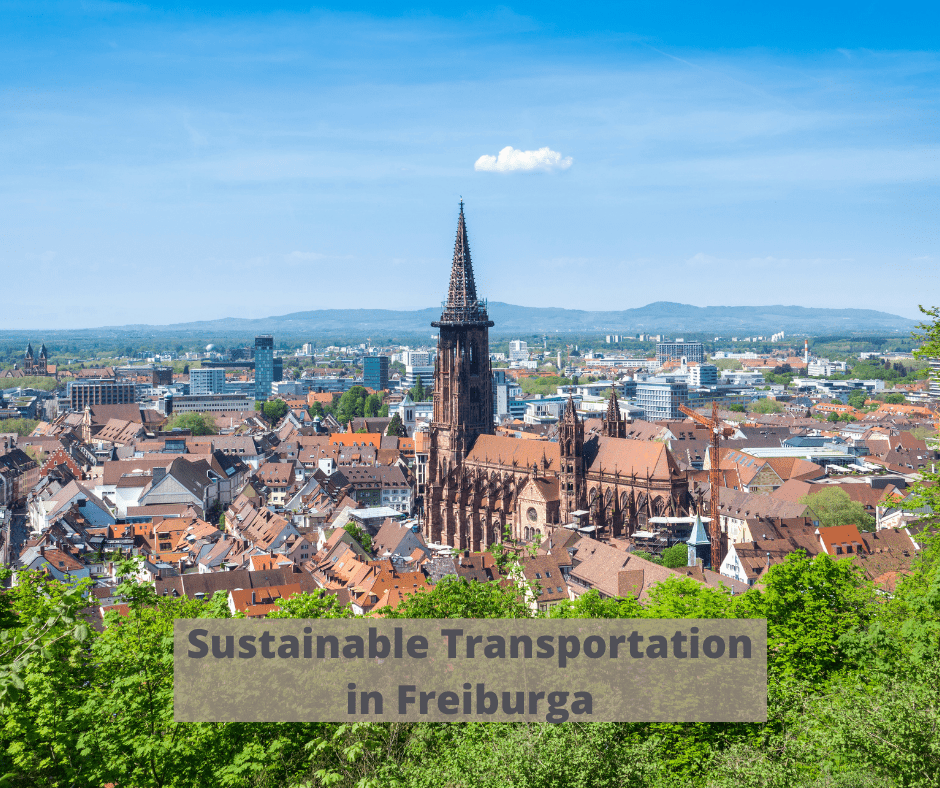Community bike-share programs are growing as a sustainable transportation solution that’s accessible for small towns, rural areas, and underserved communities. They rely on minimal infrastructure, affordable access, and strong partnerships, making them scalable and environmentally friendly. These programs benefit your health and help reduce emissions by encouraging active travel. If you want to discover how these initiatives can be expanded and improved, there’s much more to explore below.
Key Takeaways
- Community bike-share programs rely on minimal infrastructure, local maintenance, and existing community spaces, making them highly scalable and sustainable.
- Diverse funding sources, including grants and public-private partnerships, support long-term financial viability and program expansion.
- Prioritizing equitable access through free or low-cost rentals and strategic station placement promotes inclusivity and community health.
- Technology such as GPS, mobile apps, and smart stations enhances user experience, operational efficiency, and data-driven planning.
- Expanding into rural and underserved areas with electric bikes and flexible options ensures broader mobility, environmental benefits, and sustainable growth.
The Expanding Reach of Rural Bikeshare Initiatives

Rural bikeshare initiatives are expanding rapidly, showing that bike-sharing isn’t just an urban trend anymore. These programs are making strides in improving accessibility for residents in smaller communities. In places like Allen County, Kansas, a rural bikeshare with 20 bikes at four locations has already seen over 100 rides in just three months. Funded through grants like the Blue Cross Blue Shield of Kansas, they prioritize affordability and reach low-income residents who might not have other transportation options. Rural bikeshare systems require minimal infrastructure, making them easy to adapt to communities of various sizes. By focusing on accessibility, these initiatives help bridge transportation gaps, promote health, and foster community engagement outside city centers. Additionally, many of these programs utilize low-cost, adaptable infrastructure to keep setup simple and effective. Implementing cost-effective solutions ensures the sustainability and scalability of these initiatives in diverse rural settings. Exploring financing options such as grants and community partnerships can further support the growth of these programs and ensure their long-term success. Incorporating community involvement and feedback can enhance program relevance and participation. Furthermore, integrating sustainable transportation models supported by research can enhance their effectiveness and community impact.
Key Benefits of Community Bike Share Systems

Community bike share systems make transportation more affordable and accessible for everyone, especially in underserved areas. They also help protect the environment and boost public health by encouraging active travel. These benefits come together to create a more connected and sustainable community for all residents. Additionally, implementing smart technology in bike share programs can enhance user experience and operational efficiency. Employing effective asset division strategies can also ensure the long-term sustainability of such community programs. Integrating AI-powered data analytics can further optimize bike distribution and maintenance schedules, leading to improved service reliability and zodiac compatibility insights that help tailor community engagement efforts. Utilizing vetted solutions from trusted providers ensures that these systems are reliable and effective over time.
Affordable and Inclusive Access
Affordable and inclusive access is at the core of successful bike-share programs, ensuring that all community members can enjoy the benefits of cycling. These programs prioritize affordability by offering low-cost or free rentals, helping underserved populations overcome financial barriers. Partnerships with local organizations and funders, like Blue Cross Blue Shield of Kansas, support low-income residents in accessing bikes. Even in rural or university settings, minimal infrastructure—such as a few well-placed stations—can serve diverse users effectively. Flexible rental options, including short-term checkouts and long-term memberships, cater to various needs across age groups and socioeconomic backgrounds. By focusing on affordability, community bike shares help reduce transportation inequities, promote health, and support sustainable mobility for everyone. Bike accessibility is a key factor in ensuring these programs reach and benefit all community segments.
Environmental and Health Gains
Bike-sharing systems offer significant environmental and health benefits by encouraging people to choose cycling over car travel. When you opt for a bike share instead of driving, you help reduce greenhouse gas emissions and support eco-friendly urban development. Riding electric bikes further lowers your environmental footprint by decreasing reliance on fossil fuels. These systems also promote active transportation, increasing your physical activity and improving public health. As more residents embrace bike-sharing, cities can meet sustainability goals while making healthier lifestyles accessible and affordable. Widespread adoption of bike shares not only benefits the environment but also boosts your well-being by encouraging more movement in daily routines. Additionally, the integration of hydrogen fuel cell technology in transportation can further enhance energy efficiency and reduce urban pollution. Recognizing the importance of relationships and community engagement, bike-share programs often foster social connections among users. Moreover, promoting active transportation can lead to better air quality and reduce traffic congestion, creating healthier urban spaces. Implementing urban planning strategies that incorporate bike-sharing can also improve city infrastructure and accessibility. Overall, community bike shares serve as a practical, environmentally friendly way to stay active and reduce urban pollution.
Successful Examples From Small Towns and Rural Areas
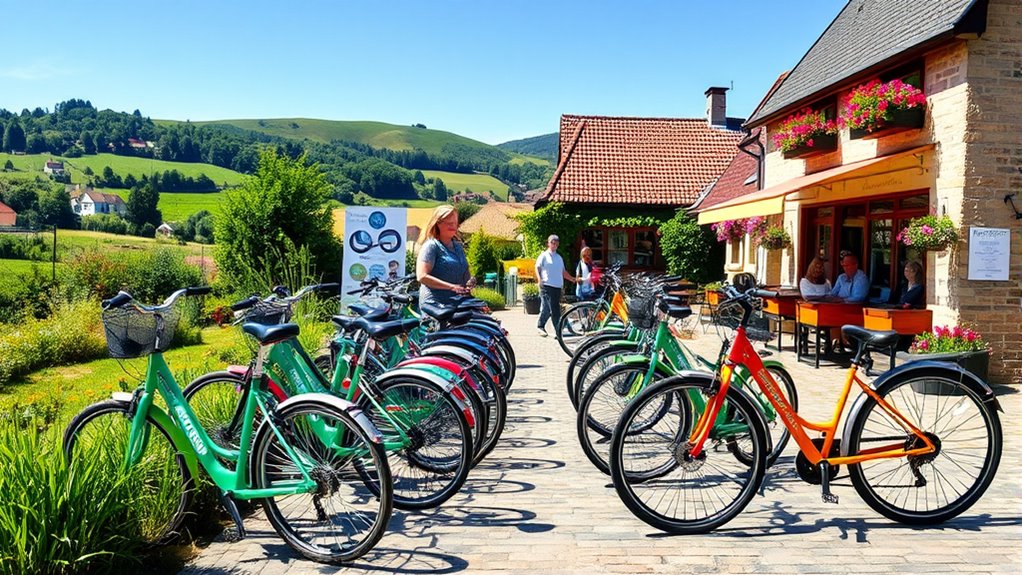
Small towns and rural areas are finding success with bike-share programs that require minimal infrastructure and keep costs low. These initiatives foster community engagement and improve mobility without the need for extensive resources. Such models prove that rural bikeshare can be both practical and impactful. Incorporating healthy eating tips and promoting active transportation like biking further enhances community well-being. Additionally, leveraging cost-effective infrastructure can boost program sustainability and accessibility in these regions. Implementing risk management strategies ensures the longevity and safety of these programs, making them more resilient to potential challenges. Utilizing platform algorithms and community engagement can also help promote these programs and increase participation. Focusing on maintenance practices can further ensure the durability and effectiveness of the bike-share systems over time.
Low Infrastructure Requirements
Rural and small-town bike-share programs often thrive with minimal infrastructure, relying on just a few stations and simple setups. These bike share programs typically use existing community spaces like non-profit centers, retail stores, or college campuses to host stations, eliminating the need for extensive construction. For example, Allen County, Kansas, runs a bike library with only four stations and 20 bikes, yet it saw over 100 rides in its first three months. Many successful rural initiatives depend on portable stations and locally maintained bikes, keeping costs low and operations flexible. This approach emphasizes affordability and community involvement, making it easy to scale without heavy infrastructure investments. Low infrastructure requirements allow these programs to serve small populations effectively, demonstrating that you don’t need a big city to run a successful bike-share program.
Cost-Effective Community Engagement
Community engagement plays a pivotal role in making bike-share programs successful in small towns and rural areas. By focusing on cost-effective strategies, communities can maximize limited resources and foster local support. For example, Allen County, Kansas, launched a bike library with just 20 bikes across four locations, resulting in over 100 rides in three months—showcasing low-cost, community-focused implementation. Similarly, Stillwater, Oklahoma’s OrangeRide offers flexible rentals and benefits from advertising revenue, creating a sustainable model connected to the university. Rural programs often require minimal infrastructure, making them highly scalable and adaptable. Funding from grants, like those from Blue Cross Blue Shield of Kansas, further supports affordable access and expansion. These examples prove that tailored community engagement effectively drives bike-share success in small and rural communities.
Expanding Rural Mobility
Expanding mobility in small towns and rural areas demonstrates that effective bikeshare programs can thrive outside urban centers. Rural mobility benefits from bike sharing by providing affordable, flexible transportation options tailored to community needs. For example, Allen County, Kansas, implemented a bike library with just four stations and 20 bikes, which resulted in over 100 rides in three months. Funded through grants like the Blue Cross Blue Shield of Kansas, these programs focus on improving health and low-income access. Similarly, Stillwater, Oklahoma, launched OrangeRide, a bikeshare system supporting campus mobility and last-mile transit. Rural bikeshare systems require minimal infrastructure, are cost-effective, and can be scaled accordingly. These successful examples prove that bike sharing can enhance mobility and health in small towns and rural communities.
Strategies for Equitable Access and Inclusion
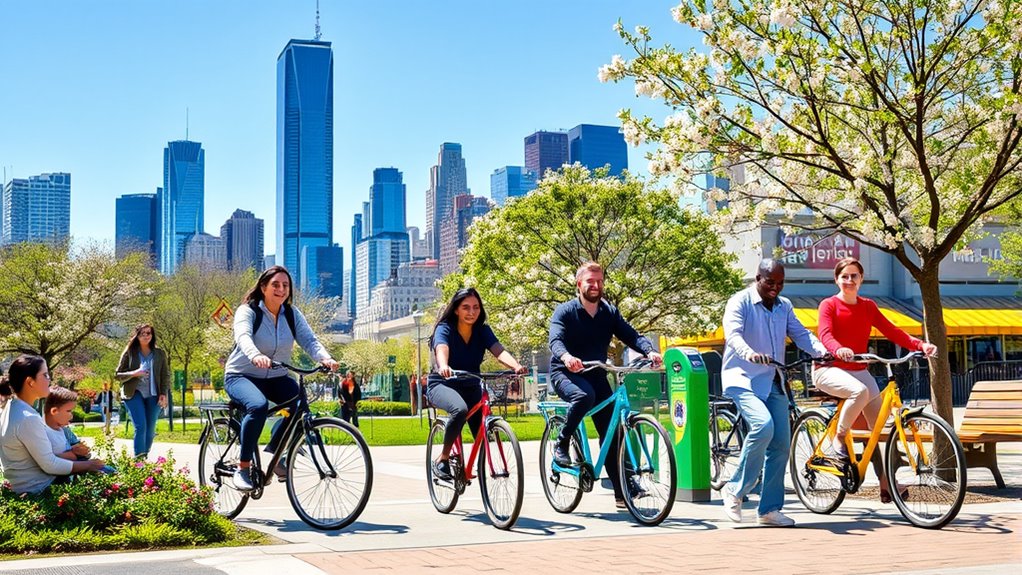
To guarantee bike-share programs are truly inclusive, you need to implement strategies that promote equitable access. Distributing bike stations across diverse neighborhoods, especially underserved areas, ensures everyone can benefit. Offering discounted or free memberships removes financial barriers, fostering inclusivity for low-income residents. Partnering with local social organizations and schools helps reach marginalized populations and encourages participation. Placing bikes near public transit hubs and community centers increases accessibility for those without private vehicles. Additionally, designing user-friendly systems with multilingual interfaces and accessible bikes supports participation across different demographic groups. These strategies ensure that all community members, regardless of background or income, can enjoy the benefits of bike-share programs, making them more equitable and inclusive for everyone.
Effective Funding and Partnership Models

You can strengthen your bike-share program by exploring diverse funding sources like grants, sponsorships, and public-private partnerships. These collaborations not only reduce reliance on user fares but also help finance innovative infrastructure and technology. Building strong partnerships with local organizations ensures sustainable support and long-term success.
Public-Private Partnership Strategies
Public-private partnerships (PPPs) are essential for creating sustainable and efficiently funded bike-share programs. By sharing funding and operational responsibilities, you reduce the financial load on local governments and improve program stability. Successful PPP models often involve private companies supplying bikes, technology, and maintenance, while governments support infrastructure and policy alignment. These partnerships can leverage private investment to introduce innovative solutions like GPS-enabled bikes and solar-powered stations, as seen in cities like Barcelona and Minneapolis. Securing long-term funding through advertising, corporate sponsorships, and grants within a PPP framework further enhances financial stability and expands coverage. To succeed, you need clear contractual agreements, stakeholder engagement, and data sharing to optimize bike distribution, safety, and growth.
Diverse Funding Sources
Building a sustainable bike-share program relies on tapping into a variety of funding sources that guarantee stability and growth. You can leverage public-private partnerships to finance infrastructure, station maintenance, and operations, ensuring ongoing support. Diverse funding sources, such as private investments, government grants, and sponsorships, help you avoid dependence on a single revenue stream. Grants from health organizations and transportation agencies can fund initial launches and expansion in underserved areas. Revenue from advertising and corporate sponsorships also supports operational expenses and boosts community engagement. Implementing flexible financial models like pay-as-you-go, memberships, and low-income discounts broadens access while diversifying your funding streams. This multi-faceted approach strengthens your bike-share program’s financial foundation, making it more resilient and sustainable over the long term.
Infrastructure Design and Station Placement

How do cities guarantee bike-share stations are both accessible and efficient? They focus on strategic station placement by targeting high-demand areas like transit hubs, university campuses, and busy commercial districts. Using data-driven analysis helps identify trip patterns and user needs, ensuring stations are ideally located. Implementing smart bike stations with GPS and solar power reduces costs and improves bike tracking and security. To promote equitable access, stations are placed near low-income neighborhoods and areas with limited transportation options. Ensuring stations are well-lit, accessible, and secure encourages safety and repeat usage. Consider these key points:
- Prioritize high-demand zones
- Use real-time data analysis
- Incorporate smart, sustainable technology
- Promote equitable access
- Ensure safety and security
Environmental and Health Impacts of Bike Sharing
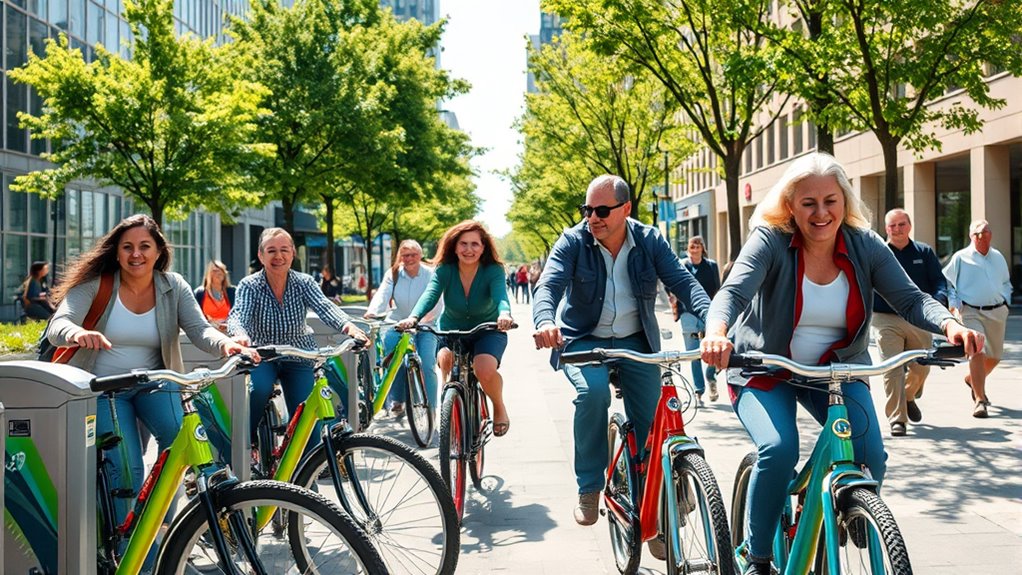
Have you ever wondered how bike-sharing programs benefit both the environment and public health? Bike sharing considerably reduces greenhouse gas emissions by replacing short car trips with active transportation, leading to cleaner air and a smaller carbon footprint. Riding electric bikes through shared systems further enhances these environmental impacts by decreasing reliance on fossil fuels and lowering energy use. Plus, bike sharing encourages active commuting, which boosts daily physical activity and improves overall health. Widespread adoption supports sustainable urban development by reducing air pollution and easing traffic congestion. Overall, bike share programs positively influence community health and environmental quality, making them a crucial part of eco-friendly mobility initiatives. By choosing to bike, you’re helping create healthier, more sustainable cities for everyone.
Leveraging Technology for Better User Experience
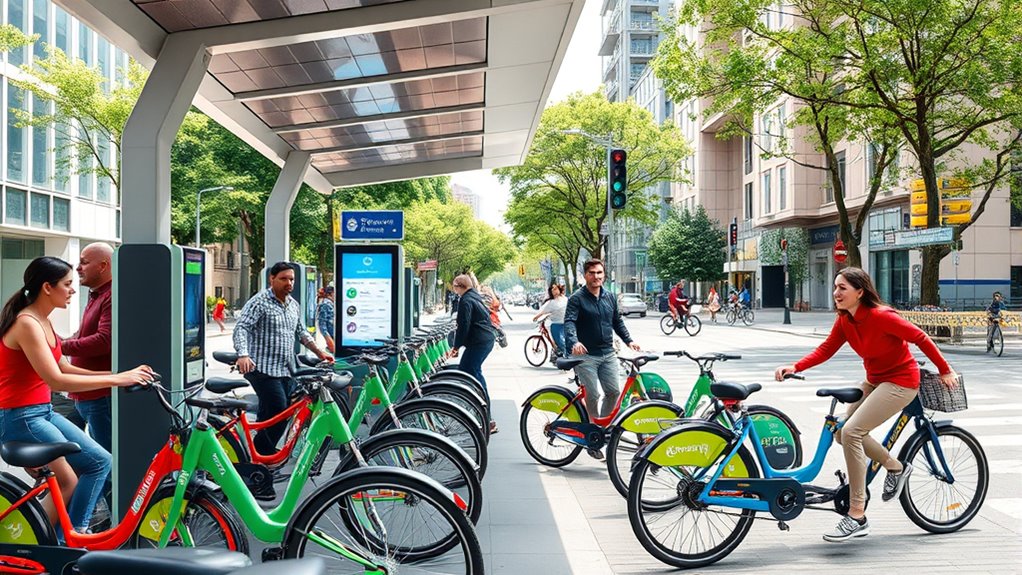
Leveraging technology has transformed the user experience in bike-share programs by making access and navigation more straightforward than ever. With GPS, RFID, and mobile apps, you can quickly locate, access, and rent bikes, boosting convenience and accessibility. Contactless payments and app-based reservations cut down wait times and simplify transactions, ensuring a smooth process. Real-time data from smart bikes and stations helps operators monitor system performance, optimize maintenance, and improve bike availability. Usage analytics reveal trip patterns, demand peaks, and popular routes, guiding strategic station placement. Additionally, digital platforms allow you to provide feedback, fostering continuous improvements and personalized services. This integration of technology elevates the user experience by making bike sharing more efficient, user-friendly, and responsive to your needs.
Overcoming Challenges in Rural and Community Settings

While technology has greatly enhanced urban bike-share systems, rural and community settings face unique hurdles that require tailored solutions. Limited infrastructure and safety concerns are common, but strategic station placement and local bike maintenance help overcome these issues. Funding through grants and community partnerships makes programs affordable and replicable. Flexibility in checkout durations, from minutes to months, encourages sustained usage. Demand depends on weather, transit access, and nearby destinations, with usage spread throughout the day. To visualize this, consider the following:
| Rural Bike-Share Factors | Impact on Usage |
|---|---|
| Station Placement | Improves access and safety |
| Transit Access | Increases rider convenience |
| Community Support | Ensures program sustainability |
| Weather Conditions | Affects ride frequency and demand |
Future Directions and Opportunities for Growth
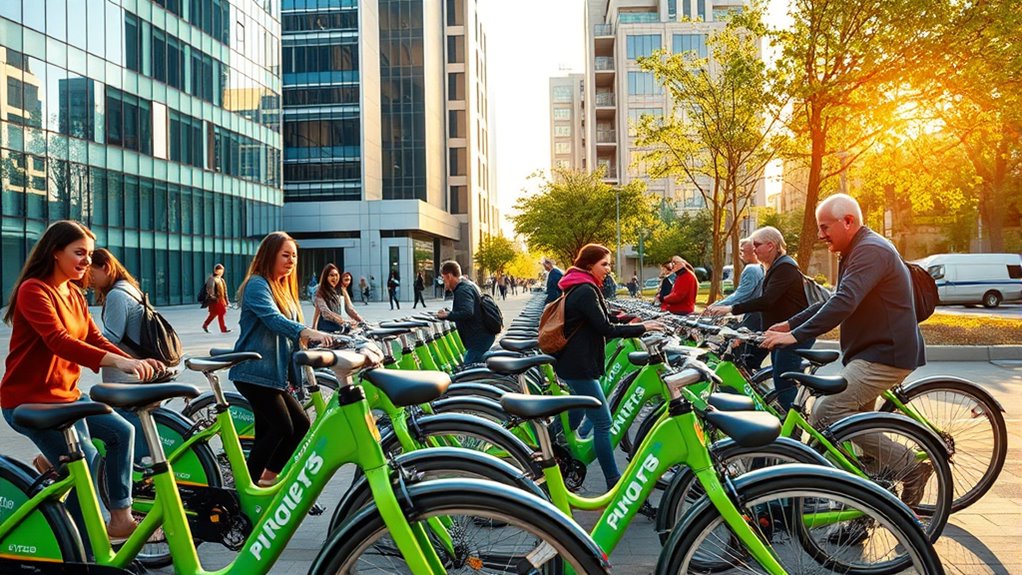
What does the future hold for community bike-share programs as they expand into rural and underserved areas? The potential to boost mobility and health benefits is significant, especially where transportation options are limited. Future directions include integrating electric bikes and dockless technology to improve accessibility and cut costs, encouraging wider adoption. Strategic partnerships with local governments, nonprofits, and businesses will be essential for funding and infrastructure. Data-driven planning will optimize station placement and service offerings, making systems more efficient. Additionally, innovations like mobile app integration, dynamic pricing models, and targeted outreach can promote equitable, environmentally friendly transportation. These advancements present an exciting opportunity to make bike-sharing systems more sustainable and inclusive, expanding their reach and impact in diverse communities.
Frequently Asked Questions
How Is Bike-Sharing Sustainable?
Bike-sharing is sustainable because it offers an eco-friendly transportation option that reduces your carbon footprint. By using bikes instead of cars, you help decrease greenhouse gas emissions and urban congestion. Electric bikes further cut energy use and fossil fuel reliance. When stations are well-placed and bikes are maintained regularly, the system stays efficient and long-lasting. This encourages active, low-impact travel, supporting healthier cities and a greener environment for everyone.
How Does Cycling Promote Sustainability?
Cycling is like planting a seed for a greener future. When you ride a bike, you cut down on car trips, reducing greenhouse gases and air pollution. You actively support energy conservation and healthier communities. Electric bikes make this even better, relying less on fossil fuels. By choosing to cycle, you’re helping decrease traffic and parking needs, making cities more sustainable and environmentally friendly for everyone.
What Are the Positive Effects of Bike Share Programs?
When you use bike share programs, you help reduce greenhouse gases by choosing eco-friendly transportation. You also boost your health through active commuting and make city travel easier, especially for short trips. These programs bring people together, encouraging social connections. Plus, they cut traffic congestion and improve air quality, making your city cleaner and more livable. So, your participation directly supports a healthier, more sustainable urban environment.
What Are the Benefits of Bike Sharing Scheme?
Imagine a simple way to make your daily commute better. A bike sharing scheme offers numerous benefits, like reducing pollution and greenhouse gases, which helps keep the air cleaner. It promotes your health through active transport, enhances urban mobility, and makes transportation more affordable and accessible—especially for those who might not own a bike. Plus, it supports eco-friendly growth, making your city a greener, healthier place to live and explore.
Conclusion
By embracing community bike-share programs, you can help build stronger, healthier, and more sustainable neighborhoods. These initiatives prove that small steps can lead to big change—reminding us that “a journey of a thousand miles begins with a single step.” Together, you can make cycling accessible, inclusive, and environmentally friendly, shaping a brighter future for your community. So, get involved and pedal towards positive change today.










